1966: Super Bowl 1 - Kansas City Chiefs vs Green Bay Packers
This series covers the history of the NFL through the prism of its yearly championship games.
Note: The gray boxes contain asides that provide interesting material but could be skipped
without losing the continuity of the article.
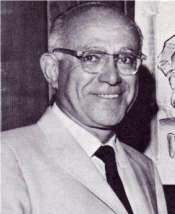
Sonny Werblin
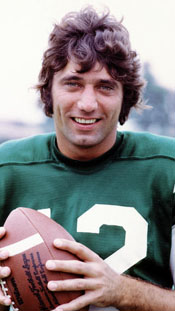
Joe Namath
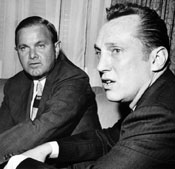
AFL President Ralph Wilson and Commissioner Al Davis

Pete Rozelle and Lamar Hunt
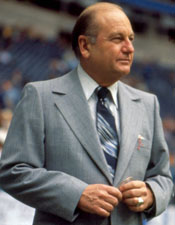
Tex Schramm
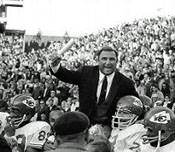
Hank Stram carried off after win over Buffalo for title
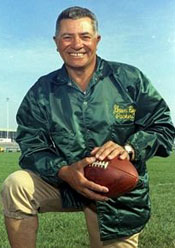
Vince Lombardi
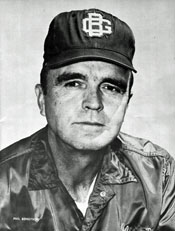
Phil Bengtson
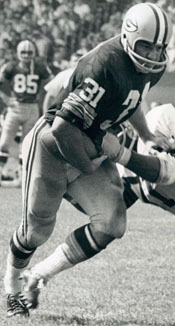
Jim Taylor

Bob Skoronski
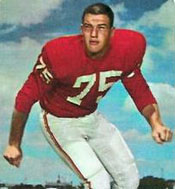
Jerry Mays
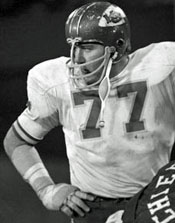
Jim Tyrer

Bart Starr
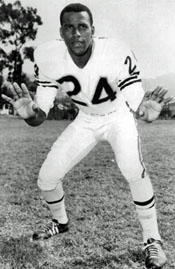
Fred Williamson
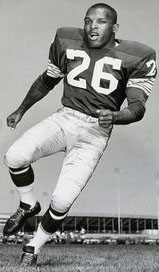
Herb Adderley
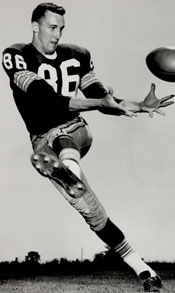
Boyd Dowler

Carroll Dale
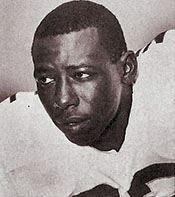
Willie Mitchell

Len Dawson
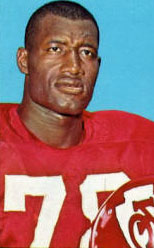
Bobby Bell

Mike Garrett
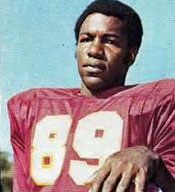
Otis Taylor
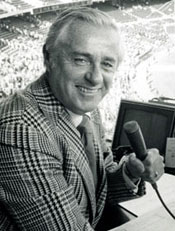
Curt Gowdy
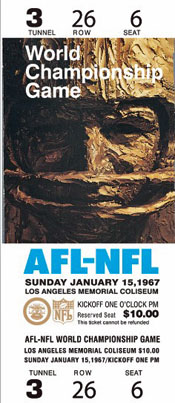
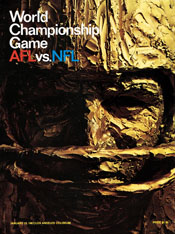
Cover of game program
|
The major news from the 1965-66 off-season in professional football was the merger agreement between the 45-year-old National Football League and the six-year-old American Football League.
- The key step in the AFL's development that produced impetus for an agreement was the 1963 purchase of the bankrupt New York Titans by an ownership group led by Sonny Werblin.
- With experience in show business and television, Werblin helped the AFL negotiate a TV deal with NBC for $8 million a season after the league's five-year contract with ABC expired. That gave each team in the upstart circuit extra cash with which to sign draft choices.
AFL founder Lamar Hunt, the owner of the Kansas City Chiefs, praised NBC and Werblin. NBC did the smart thing. Most of our clubs needed big money from TV to compete with the NFL. It was a smart business move for NBC to have a strong AFL, and Werblin was the guy who made them realize that.
- Sonny followed up on that success by signing Alabama QB Joe Namath, the #1 draft choice of his club (now named the Jets), to a $427,000 three-year contract after the 1964 season.
- The battle between the leagues heated up in the spring of 1966 when the AFL elected Oakland owner Al Davis as commissioner. Al immediately implemented an aggressive policy of outbidding the NFL for top draft choices.
- Clandestine meetings between Kansas City owner and AFL founder Lamar Hunt and Dallas Cowboys GM Tex Schramm, the longtime friend and personal representative of NFL Commissioner Pete Rozelle, led to the June 8 announcement of a merger between the two leagues. The major points of the agreement were:
--Rozelle would be the commissioner of the merged league;
--An annual world championship game between the champions of the two leagues would be held beginning in January 1967;
--A common draft would be held starting in January 1967;
--Interleague preseason games would begin in 1967;
--A single league schedule for the 1970 season would complete the merger.
It was fitting that Hunt's Chiefs represented the AFL in the first NFL-AFL Championship Game.
- KC compiled the league's best record of 11-2-1, including a victory over the AFL's new team, the Miami Dolphins.
- Led by QB Len Dawson, the Chiefs scored 448 points, 90 more than any other club and also led in total yardage with 5,114, almost 400 better than the second place club.
- The KC defense also excelled, allowing 276 points, second only to Buffalo's 255, and 3970y, also second to Oakland's 3910.
- The Chiefs dominated the 1st-team All-AFL team:
Offense: QB Len Dawson, FL Otis Taylor, TE Fred Arbanas, T Jim Tyrer, G Ed Budde
Defense: DE Jerry Mays, DT Buck Buchanan, LB Bobby Bell, S Johnny Robinson.
- Hank Stram's club climaxed its season with a 31-7 lambasting of the East champion Buffalo Bills on the road in the AFL title clash for the franchise's first championship since 1962 when they were the Dallas Texans.
As the game wound down, an exuberant Stram was already thinking ahead. Pour it on, boys! he urged. There will be a lot more when we tear apart the NFL.
When told what Hank said, Lombardi smiled. Good for Stram. If he said anything else, I wouldn't have respect for him.
The NFL added a new team for the '66 season.
- The Atlanta Falcons joined the Eastern Division.
- The expansion team finished 3-11, which topped the woeful Giants' 1-12-1 mark.
The Green Bay Packers began defense of their NFL championship with a roster of aging veterans sprinkled with youthful additions.
- With Vince Lombardi tolerating no slacking off after their third title in five years, the Packers won 12 and lost just two - by a combined 4 points.
- Like the Chiefs, the Pack was solid on both sides of the ball although Green Bay's forté was defense.
- Phil Bengtson's unit gave up only 163 points, 49 fewer than 2nd-best Los Angeles.
Jerry Burns, the Packers' defensive backfield coach in 1966 and later head coach of the Minnesota Vikings: I coached for 40 years, and Phil Bengtson was the best defensive coach I've ever known. He set the whole game plan. Phil always preached that we'd play our game ... We had a middle linebacker like Nitschke who could keep people off him and make the plays.
- While in the middle of the pack in yardage (4275), the Green Bay offense tied with the Dallas Cowboys for fewest turnovers.
- Those two error-minimum clubs met for the NFL title in Dallas. An interception in the end zone as time ran out saved the game for the Packers 34-27. (Read about the 1966 NFL title game ...)
After defeating the Bills in Buffalo for the AFL championship, the Chiefs gathered at the Holiday Inn to watch the NFL title game before flying back to Kansas City. While it would have been interesting to face their old intra-city rivals from Dallas, the squad was grateful for the opportunity to meet the NFL's dominant team in the first Super Bowl.
- Eight Packers dotted the All-NFL squad:
Offense: QB Bart Starr, T Forrest Gregg, G Ron Kramer
Defense: CB Herb Adderley, S Willie Wood, LB Lee Roy Caffey, LB Ray Nitschke, DE Willie Davis
It wasn't until December 1 that the planning committee chose Los Angeles Memorial Coliseum as the site of the game. The date was set for Sunday, January 15, 1967.
- The committee consisted of Rozelle and three owners from each league - Schramm, Carroll Rosenbloom (Baltimore), and Dan Reeves (Los Angeles) from the NFL and Hunt, Ralph Wilson (Buffalo), and Bill Sullivan (Boston) of the AFL.
- Hunt began calling the game the "Super Bowl" in committee meetings as early as July. He got the inspiration for the name when his daughter played with a "Super Ball" that bounced higher than the average ball.
- The term quickly caught on with the media and the public although it was not the official title of the first game.
- Rozelle hated the name. He felt it was undignified. He stated, To me, "super" was a corny cliché word that we used during my school days at Compton High in California in the 1940s.
The word was in the same class as "neat" and "gee-whiz" - no sophistication. The committee agreed and dubbed the game "The AFL-NFL World Championship Game."
Rozelle later acknowledged: I am the first to admit that I was mistaken about the name of the game. "Super" takes on a different connotation when it is applied to this event. I think the name has played a big part in the game's success.
- It was Pete's idea to play the game at a neutral site. He also wanted two weeks in between the two league championship games and the world championship clash.
Rozelle's first choice for Super Bowl 1 was the Rose Bowl, but the exectives of college football's oldest bowl game did not want a professional game in their hallowed stadium.
Rozelle wanted the two teams in California at least a week before the big game to help promote it.
- Lombardi wanted to stay in Green Bay and fly to Los Angeles the Friday before the game. But Rozelle wouldn't hear of it.
- Vince's counterproposal was to stay in Palo Alto, 400 miles away, where the Packers always stayed during the week between their traditional season-ending games at Los Angeles and San Francisco. But Pete wanted them closer to Los Angeles.
- Wanting no part of Tinseltown with its night life, Lombardi got the Commissioner to agree to the Packers practicing at Santa Barbara, 95 miles up the coast from L.A.
One reason the former Catholic seminarian wanted Santa Barbara is that he considered it good luck to stay in cities named for saints.
- Meanwhile, Stram brought his Chiefs to the West Coast 11 days before the game. They stayed at Long Beach, on the ocean 22 miles south of the Los Angeles Coliseum. Hank had actually made the arrangements before the AFL title game in Buffalo.
Stram would regret his decision. We had come to California too early. The two weeks felt like a month. They had been ready to play four days earlier [than the day of the game].
The Packers spent the first week following the NFL championship victory working out in Green Bay.
- The typical Wisconsin winter weather was exactly what Lombardi wanted for his team to keep their edge. He told the team: We've just beaten Dallas for our second straight NFL championship. But you know something? If we lose this game, the season won't mean anything. If we lose, people will remember us as the NFL team that lost to Kansas City in the first game played between the leagues. ... There is no way - NO WAY - the Green Bay Packers are going to lose this football game.
- When the team arrived at the Santa Barbara Inn, Vince was appalled. They were staying at a resort! The players will think this is a vacation, not a business trip! He immediately ruled the swimming pool off limits.
Bud Lea, the Milwaukee Sentinel beat writer for the Packers who flew with the team to California, recalled: When Lombardi got a first sight of the majestic mountains that surrounded the plush Santa Barbara Inn and the oceanfront view, he was irked. That was all he needed - a luxurious resort, a vacation haven. He wanted something basic, barren.
- To keep them focused and off the streets, he established a training camp schedule: two practices a day with meetings every night after supper.
Packer WR Bob Long: There was hardly anything going on in Santa Barbara ... Santa Barbara had just one place that remained open past 10 at night - the Western Union Office.
- The Packers practiced at the brand new stadium on the campus of the University of California, Santa Barbara. The turf presented quite a contrast from the frozen tundra of Lambeau Field.
Damn, I almost feel quick, exclaimed 31-year-old FB Jim Taylor while warming up for the first practice.
Worried about someone spying on his practices, Lombardi had the storm fence at the open end of the field covered with a green canvas. He also told the offense to run its plays away from the mountains so they wouldn't be distracted by the scenic view.
Vince also pulled little tricks like telling the players the bus would leave for practice at 9:30, which, in Lombardi time, meant everyone should be on board at 9:15. Then he told the driver not to leave until 10. That way, he used up 45 minutes of his players' time.
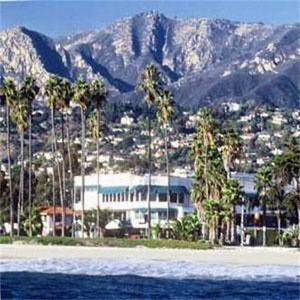 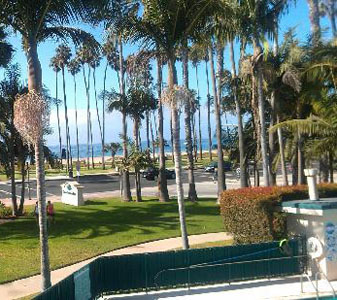
Santa Barbara Inn
- Lombardi also increased his fines to $2,500 for a minor violation such as being late for a meeting and $5,000 for a major violation like breaking curfew - startling figures for players making less than $25,000 a year.
G Bob Skoronski recalled: I had never felt such a sense of urgency on Vince's part before. It was obvious to all of us ... that never before had we played in a game that Vince Lombardi wanted to win more. ... The first few days in California were the most tense of the season. The schedule, the conditioning, the seclusion and the discipline were starting to get to us. The guys were edgy, some were mean as hell. But Vince was still pushing, still working on us.
- If Lombardi was even more irascible than usual, blame the extreme pressure being laid on him by the NFL owners to beat the Chiefs solidly to vindicate the older league's self-proclaimed superiority.
Vince was particularly touched by telegrams he received from the two oldest NFL owners, George Halas of the Bears and Wellington Mara of the Giants. Good luck, best wishes. We are proud you and the Packers are representing us, the NFL, in this first game ... Mara, Vince's good friend from his time as Giants offensive coordinator, wrote: I could think of no other standard-bearer that I wanted to carry our banner into battle.
A worry wart even when the stakes weren't as high, Lombardi couldn't sleep the week leading up to the big game.
- In one of the daily interview sessions, a writer recited a litany of reasons why Kansas City didn't belong on the same field with the Packers. When Lombardi finally got a chance to reply, he was at his sarcastic best: Thank you. That was nice. But those people on the other side of the field don't realize that the championship has already been won. This is their chance. For seven years we've been saying they aren't as good as we are. That's fine. But suppose they are? How can I convince them in advance that the championship has already been setlted? I think we'd better wait and play the game, if that's all right with the gentlemen of the press, of course."
- When the Packers finally moved to L.A. two days before the game, they stayed at a hotel 20 miles from the city center.
In his press conference upon arriving in Los Angeles two days before the game, Lombardi admitted he had never seen an AFL game, live or on TV. Come on, Vince, even Pete Rozelle has seen at least one AFL game, said a reporter. Maybe Pete has more time than I do, Vince replied.
Kansas City, by contrast, could approach the game with a nothing-to-lose attitude.
- We're the kids from across the tracks, said DT Jerry Mays, the Chiefs' defensive captain. We're coming over to play the rich kids.
- Stram was a taskmaster in his own right even though his public persona was more amiable and less intense than Lombardi's. The Chiefs players also complained about the training camp-like practices.
- The KC coach studied films on Green Bay for hours at a time. Stram felt confident he move the ball on them since the Packers used just one defensive alignment, a basic 4-3, but had great pursuit no matter where you ran or passed the ball. They rarely blitzed. He also saw a very predictable offense on the Pack.
Stram: When they were in a halfback, fullback formation, they ran to the weak side with Jim Taylor. When they had split backs, they'd usually run to the strong side with Paul Hornung.
But what Green Bay did on offense, they ran very well, causing Hank to worry that his defense would have to play above their heads to stop the Pack. A case of the flu had dropped the weight of DE Chuck Hurston to 215. MLB E. J. Holub played on two bad knees, and another linebacker, 29-year-old Sherrill Headrick, was entering the waning years of his career.
- Hank used the fact that all pundits predicted a Green Bay victory to motivate his troops. Believing AFL football was better than the NFL gave it credit for, the KC coach genuinely felt that, if his team avoided mistakes, they could defeat the Packers.
Stram felt pressure in his own right to represent the AFL well. Everyone has waited for this game for a long, long time. You'd have to call it an historic occasion ... To be a member of the first team to represent our league is a deep privilege ... There is a great deal at stake.
Hank admitted in his autobiography: Maybe I was putting too much pressure on myself to win, but we had a lot more to play for and so much to prove.
Dawson echoed those sentiments. You can't imagine the pressure we faced in the first Super Bowl, because we weren't just playing for each other and the great fans in Kansas City. We were playing for an entire league.
- Independently, Stram managed to create an atmosphere akin to what Lombardi would enforce further up the coast. OT Jim Tyrer: Almost all of the players ... were intense as hell. The life-style at the motel contributed to it. The whole scene was like training camp again. The coaches were making bed checks, and every minute of the day was planned out for us.
Newark Star-Ledger columnist Jerry Izenberg had breakfast with Chiefs LB E. J. Holub two days before the game. We were talking, and he reached across the table and said, "Feel my hands." His palms were said. And I said, "Is this because you're going to be the first team ..." He said, "No. Do you realize if we win the game, I can take out $15,000?"
Rozelle invited media from all over the nation to come to Los Angeles a week before the game.
- As an enticement, he offered access to both teams outside of practice times. He even offered a bus to take reporters to Santa Barbara or Long Beach although only one consistently took the Santa Barbara bus. The others car-pooled.
- No times were set aside in the teams' daily schedule to meet with the media. But reporters could interview players at meals or just knock on their doors. Under instructions to be cooperative, the players invited reporters into their rooms for chats.
Starr: We had been playing in championship games for years, but we had never seen so many media people in our lives.
- Stram welcomed the opportunity to talk to the media in order to promote his underdog team and league. But Lombardi cooperated grudgingly. This was one of the distractions he wanted to avoid by staying in Green Bay.
Lombardi never had the patience to answer the same question again and again. The query that irritated him the most was, Is the NFL a better league than the AFL? He growled, I'll answer that after the game.
- The league would issue 1,049 press credentials for the game, an unheard number at that time.
One Kansas City player caused problems for Stram and the other Chiefs.
- CB Fred Williamson, at 6-3, 210 among the tallest and strongest of cornerbacks in pro football, boasted that he owned a black belt in karate and had a weapon he called "the Hammer," a hard forearm chop across the helmet.
- He promised to use the weapon on the Packer receivers, who didn't impress him. The Packers would know who he was by his white shoes. I've broken thirty helmets with my forearm alone. I can't wait to add to my total against the Packers.
- Fred unabashedly called himself the best cornerback in football. When someone asked him to compare himself to Herb Adderley of the Packers, The Hammer replied, Who's Adderley? The former Northwestern cornerback also belittled Green Bay FB Jimmy Taylor. He would have been no big deal in our league. Jim Nance (of the Boston Patriots) runs a lot harder.
- I'm going to hit Dowler with the hammer, Fred boasted. If you ask Mr. Dowler the definition of the word hammer, he will tell you it's an instrument which drives a nail into a board. But if you ask him Sunday night, he will have a new definition of the word. ... Dowler has two options. If he catches the ball, he must sacrifice his body. If he does not catch it, he can go free.
Williamson also offered some uncontroversial remarks about the Packers' receivers that proved prescient. The problem in covering these tall receivers is that, when they run curl patterns and short hooks, they are so big, they shield you from the ball.
- Relaxing at the Packers' motel, Dowler was told of Williamson's remarks. We've never played against each other, but if I catch the ball, I'm not going to worry about what he does. We've watched him on film. Those white shoes only make his feet look big. Otherwise, he's a pretty good defensive back. ... I feel that anybody who lets you catch the ball just to hit you isn't playing team football. My job is to catch the ball, and that's what I intend to do Sunday. I'm surprised that he singled out me. I won't be on his side that much, but Carroll Dale will. His remarks don't make us angry. We're all more amused than anything else..
Packer DT Henry Jordan kidded backup WR Max McGee. Max, you're lucky you probably won't be playing ... "The Hammer" is looking for blood."
Max laughed. Hell, he's nothing but a cheapshot artist. I'll be sure to warn Carroll (Dale) and Boyd.
Dale's reaction to Williamson's boasting was succinct. That kind of talk is good inspiration for working on downfield blocking.
Packers DB Willie Wood ran around with a sock full of sand hitting people in the helmet saying, Hey, The Hammer gocha! You've been hit by The Hammer!
C Bill Curry: Guys chuckled because we'd had other people who talked big before playing us. And what it said was, "We're scared."
Skoronski: The only laughs we had all week were when we read the papers and saw what Fred Williamson had to say.
- Williamson recalled: The third day on the coast, the Packers hadn't arrived yet, so the writers and TV guys were following me around night and day, calling my room, hanging around the motel restraurant, leaving messages for me to call them. When I went through my messages, there was one from Hank Stram, the coach. It said he would like to see me. Stram didn't appreciate the bulletin board material Fred gave the opposition. Williamson: He said, "Didn't we warn the entire team ... to watch what was said to writers, to avoid making any statements that would fire the Packers up? Fred then explained that he was trying to fire up his own team, not the opposition. On the airplane, somewhere between Kansas City and Los Angeles, I realized this team was scared to death. I looked around me, and all I saw were zombies. These guys were scared of playing the Green Bay Packers. They were scared of playing in the first Super Bowl, scared of the unknown. So I said to myself right then and there, "Hammer, there's only one guy around here who can snap this club out of it - you." ... So many guys had copped out to themselves already that I knew we were going to get our asses whipped unless something drastic happened to wake them up. Hell, we shouldn't be happy just to be plaing in the same game with them. We should be concerned with beating their sorry asses! But all Williamson succeeded in doing was making his teammates mad at him.
Tyrer: Fred Williamson's motives were suspect, as far as I was concerned. The guy was always looking for attention, not for the Chiefs, not for the defensive unit, but for himself ... He was throwing a lot of half-truths around, and I think he put a lot of unnecessary pressure on himself and Willie Mitchell in the defensive secondary.
Williamson: When the Packers got out to California, I knew my plan wasn't working. Sheeit, these guys picked up the papers, read where the Packers arrived and nearly died. The Packers beat us by stepping off the airplane. Coaches were running around, drawing their X's and O's ... They had diagrams and play books and theoretical answers for everything. But they couldn't see the forest for the trees, man. This team didn't need any X's and O's. It needed confidence and somebody to say, "Yeah, you cats gonna whip those Packers' asses. Yeah, you cats gonna be world champions."
The Packers started as seven-point favorites, but the line increased to 12.5-13.5 points by game time.
- Each team received films of three games of its choice from its opponent. Both sides wanted the other's championship game.
- From their film study, the Packers thought the KC offense mirrored the Dallas Cowboys' attack in many ways - confusing the defense with shifting sets that disguised the formation until the last second.
- Packers' D-coordinator Phil Bengtson saw that the Chiefs' play-action style passing attack was susceptible to a linebacker blitz. But he decided not to blitz during the first half. His idea was to build up a false sense of security in Lenny Dawson and save the surprise of a blitz until the second half. Lombardi approved that approach.
- In his autobiography, Bart Starr summarized the Packers' approach to the game. We were highly confident we would win, but only because we believed in our abilities, not because we took the Chiefs lightly. Psychologically, the Chiefs were in a unique position. On the one hand, they didn't have to face the pressure we did, because a good showing on their part would be enough to quiet the critics. On the other hand, they lacked big-game experience.
- No one could dissect a defense like the Packer quarterback. His film study showed that physically, the Chiefs certainly belonged on the field with the Packers, or anyone else for that matter. Their linemen were bigger than Green Bay's. linebacker Bobby Bell, RB Mike Garrett, Dawson and receiver Otis Taylor ... all were fluid athletes who could play with anybody.
- But the All-Pro quarterback from Alabama added: I know, when I'm watching one of the NFL teams in action against one another how good the individuals are because I have played against them. But watching the Chiefs play against other teams in the AFL was like watching strangers. I didn't know how fast the defensive backs were, and I couldn't read their defenses very well. So I had to be careful for a while until I could figure them.
- Kansas City's triple-stack defense, which hid the linebackers behind a massive D-line, shut down running games and dared opponents to pass. But Bart quickly spotted their weakness - cornerback. Their defensive backs were not poor athletes, but their defensive strategy often left those players responsible for covering receivers with little help. ... To compound the problem, Kansas City liked to blitz their linebackers ... Our receivers practiced especially hard that week, as they knew they would be seeing plenty of passes thrown their way.
- Chiefs S Johnny Robinson had a healthy respect for the Packers. We are just going to have to hang tough in there. I don't see how we can stop them from getting maybe four, five yards at a crack, so we'll have to wait and hope for the breaks and take advantage of them.
- The inventor of the moving pocket who ran what he called "the offense of the future," Stram used the two weeks of closed practices to add new wrinkles to the 18 offensive sets and 350 plays his offense already employed.
- By contrast, preparing for the Packers was simple. They were pure vanilla, Stram remembered. We saw everything in the AFL, and here we were, preparing for a team that defensively used just one alignment and one coverage. It was unbelievable, but they were good enough to get by with it. ... They did things right and with maximum force. Everyone went all-out every second. Still, I was sure we could move the ball on their conservative defense. ... I sincerely believed we could win. We'd have to play the best game of our lives to do so, and the challenge was to sell the players on the idea.
- The prizes for the winning and losing teams were set in advance and did not depend on the gate receipts. Each member of the victorious team would receive $15,000 and each loser would take home $7,500.
Rozelle imitated King Solomon cutting the baby in half in deciding which network would televise the game.
- CornerbackS held the exclusive contract for NFL games while NBC had a similar pact with the AFL. The two networks paid a combined $2 million to the two leagues.
- So Pete decided to cut the baby in half and let both networks televise the first game.
The two media giants began alternating coverage the following year, with CBS handling Super Bowl II and NBC doing III, which produced the first AFL victory in the series.
- However, CBS's cameras would be used, and NBC would share the video feed with their own audio and commercials. This, of course, didn't sit well with the NBC people at all.
- With CBS unhappy because they didn't have an exclusive broadcast and NBC upset that they had to play second fiddle to their rival, sparks often flew, especially among the technicians.
Curt Gowdy, NBC's lead announcer, recalled the ridiculousness of the network competition. I can remember there was a fence up between the (production) trucks in the compound. ... it got to be like the space launches. There were meetings every day between the two networks, and they were hysterical. ... They we'd go and try to figure out how to screw CBS, and you knew they were doing the same thing. There was as much a rivalry between the networks as between the leagues.
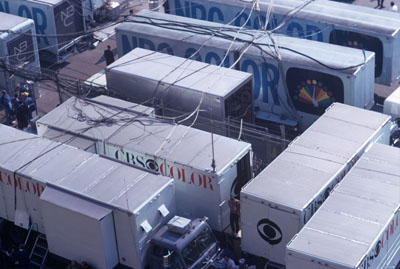
Fence between the CBS and NBC production trucks
- Expecting monster ratings, CBS charged $85,000 for a one-minute commercial, while the Peacock Network asked $15,000 less. Advertisers who couldn't afford those prices could fork over $40,000 for a 30-second spot.
- Both networks, determined to win the ratings battle, promoted the game vigorously during their prime time shows. CBS used the term "Super Sunday" in its ads, which took up 75% of its primetime promos and 50% of its daytime spots. NBC devoted 505 of its evening spots to push its telecast.
Ford and Chrysler were major advertisers for the game. Others included McDonald's ("Over Two Billion Served"), Muriel Cigars, Coca-Cola, and Tang.
An estimated 51,000,000 would watch the first Super Bowl, the largest number for a sporting event at that point in time. CBS's ad saturation the week of the game paid off as the network won the ratings battle 22.6 to 18.5 for NBC. CBS also benefitted from a pregame showing of an exhibition game involving the Harlem Globetrotters. Super Bowl 1 remains the only one to be televised by more than one network.

Ray Scott and Frank Gifford in the CBS-TV booth during Super Bowl I.
|
The Friday night before the game, Rozelle held the first annual Commissioner's Party.
- NFL and AFL owners, front-office staff, key media, and spouses partied in the ballroom of a downtown L.A. hotel.
- NFL owners and their wives were given red rose corsages. AFL owners and wives received white roses. The unbiased media received neither. However, Tex Maule of Sports Illustrated, who had predicted a Packer rout, unabashedly took a red rose and put it in his lapel.
That same night, the Packers' first in Los Angeles, Paul Hornung went to dinner with his friend, golfer Bob Rosburg.
- Rossy wanted advice on how to bet on the Super Bowl against his friend and fellow golfer Jimmy Demarest, a big AFL fan.
- Bet on the Packers, Paul told him.
But you aren't playing.
They don't need me.
After describing the incident in his autobiography, the Packer Golden Boy whom Rozelle had suspended for the entire 1963 season for betting on football, wrote: That made me think. This is probably my last game. I loved us to win. Should I bet on the game or not? I hadn't made a bet since I had been reinstated. Then I figured the hell with it. I didn't bet, but I wanted to.
Tickets sales were not what Rozelle expected, and one-third of the 94,000-seat Coliseum would be empty.
- Editorials railed against the exorbitant ticket prices: $6, $10, and $12. We laugh today at those prices, but the most expensive seat for the 1967 Rose Bowl game was only $6.
- Local fans were also incensed that the game would be blacked out in the L.A. area sellout or not. A local businessman filed a law suit asking a federal judge to issue an injunction prohibiting the blackout. District Judge William Green ruled that the regional blackout was justified on legal terms but added that he personally felt the blackout was discriminatory against the residents of southern California.
- Newspaper articles instructed viewers on how to pull in the game from Bakersfield, Santa Barbara, and San Diego.
- 338 print media and 262 electronic media credentials were issued.
In the Packers' hotel on Wilshire Boulevard, assistant coach "Hog" Hanner conducted a bed check Saturday night.
- The team's two leading playboys, 31-year-old Paul Hornung and Max McGee, three years older, shared a room.
- Neither expected to play the next day. Hornung appeared in only nine games because of injuries and hadn't taken the field against Dallas the week before. McGee caught just four passes all season.
- When Hanner checked their room, McGee was under the covers with his clothes on. After Hawg moved on, Max invited Paul to hit the town with him, promising a hook up with several stewardesses. With his wedding three days away, Hornung turned down the offer.
After watching films of the KC secondary, McGee expressed confidence in an encounter that evening. Talking to Ray Scott, the Voice of the Packers, Max boasted, I don't know if I'll get in the game, but if I do, they'll never get me out. Ray, I've found me a cornerback I'll have for breakfast, lunch, and dinner!
|
|




























